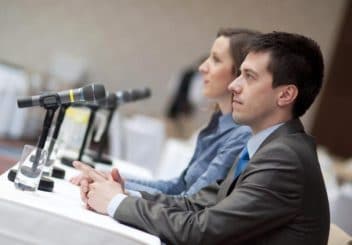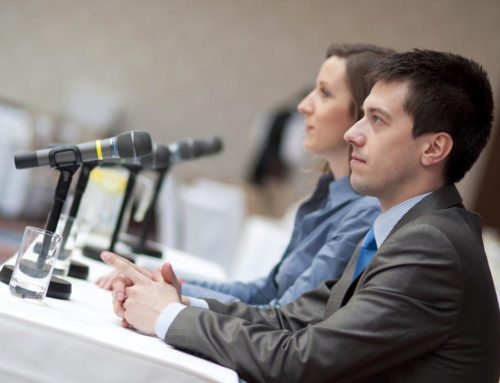Organising a scientific event
Scientific events can take many forms, whether they are held in person or online: conferences, award ceremonies, innovation competitions, doctoral days, Science festivals, team seminars, etc. As you can imagine, several steps are necessary to organise a corporate or public event. Agent Majeur offers a behind-the-scenes glimpse into the guidelines that serve to successfully run an event.

Step 1: design the event concept
For starters, you must determine the stakes and the objectives of the event. Here are a few questions to guide you in this process:
– Why do you wish to organize this scientific event: to reward, to acknowledge, to federate, to announce, to promote?
– Who is the public and what are the expectations of the audience?
– What will be the format of the event: in person, online, or hybrid?
– When and where will the event take place?
– How many people will participate?
– What is the budget?
– Who will the speakers be?
– What is the program?
By reflecting on these questions, you will be able to define the message you want to convey, and the name and the slogan of this scientific event. Furthermore, you will be able to understand why your target audience will attend. Whether they are researchers, partners, funders or the general public, you will need to meet their expectations with a tailor-made programme.
For example, for a conference or an online congress, it is possible to plan 2 days including workshops, panel discussions and conferences. To present an innovation, one can consider holding a demonstration stand for just one afternoon. For a scientific awards ceremony, an evening reception is a good option. It could include official speeches, videos and presentations from the winners, and finish in style with a cocktail dinner.
Step 2: Plan the event
The date and time of the event must be set from the outset. Indeed, it is not always easy to find providers and available venues suited to your requirements. In the case of a hybrid or in-person format, some event venues need to be booked several months, or even a year, prior to the big day. Is this event taking place on weekdays or over the week-end? During the day or in the evening? Does the site need to be an enclosed area or an open space? There are many possibilities, an exhibition hall, an amphitheatre, a seminar room, etc. There are also different types of room layout: u-shaped, classroom, banquet or even buffet. At this stage, a tour of the place is essential to scout the venue and imagine the event. You will also need to build a provisional reverse schedule to meet deadlines.
Step 3: Clarify the program of the event
Once the venue is booked, it is time to develop an in-depth reflection on the event. Do you know how many rooms are available, their size, their schedules? What will be the content of your scientific event? Will there be hosting, gifts? Do you need to plan a schedule for several rooms in parallel? What will be the precise schedule, minute per minute? Do not forget your speakers: they need to save the date, because their presence is indispensable for the success of the event.
Step 4: Organise your event
Your project is well thought out. You now need to think of the necessary financial, material and human resources to run the event. Even if you have thought of these aspects earlier during the project, it will become crystal clear at this stage. To get quotes from providers, contractual specifications will be necessary. If you hire an event agency, it can accompany you from the get-go and find all the resources you will need.
You need to cover many topics during the organization of your event: registration, access badges, connection to the video conference platform, transportation, hosting, catering service, hotel reservations, photographers, technical production (lighting, sound, translation), audio-visual production (filming, directing, editing, broadcasting), room layout (signposting, decorations, cloakroom), security service…just to name a few.
For an in-person event, signposting is essential to manage crowds. Welcoming and guiding your participants is also key. Participants appreciate it when they are led at the exact location of the event. Nobody likes to wait outside under the rain! And above all, make sure participants know how to find their way inside the venue: cloakrooms, toilets, lifts, exits, etc.
For an online event, make sure that the audience can easily find the information they need. Try to put it all on a dedicated webpage with the program and the login information. Hospitality is also important online. For example, you can play a jingle while the audience waits, display a countdown before the beginning of a conference or workshop, etc. Do not let participants wait all alone in front of a dark screen!
Step 5: Communicate on the event
If you want people to attend the event, you need to communicate. If you are inviting a select audience, prepare an invitation. It can be sent by email and by post. It is advisable to send a “save-the-date” beforehand to encourage your target audience to reserve the date in their calendar.
If your event is for a wide audience you can use more or less specialized media: intranet site, social networks, company magazines, scientific or generalist journals, etc. Digital communication brings you closer and makes it possible to interact with your community. Different means exist, such as the creation of a website specially for the event, a Facebook page, articles on your blog or those of your partners, the many social networks (Twitter, LinkedIn, Instagram), influencers, etc.
Other media can be created to promote your scientific event: flyers, posters, etc. In addition, it is possible to release a video teaser to spark the curiosity of your audience. Be sure to communicate on social networks during and after the event. It is an excellent way of extending the experience beyond the walls and over time.
Step 6: Make your event a success
It’s D-day! Your event will finally take place. To ensure its success, we advise you to do a rehearsal. This will allow you to fine-tune the final details such as stage entrances and exits, activation of jingles, microphone tests, lights, etc. For a digital or hybrid event, the technical rehearsal needs to take place several days in advance, to anticipate network problems and test the use of the video conferencing software.
One of the keys of a successful event is anticipating and addressing contingencies. You will very likely need to deal with unexpected mishaps. Which is why it is wise to provide a contact list to all the members of your team in case there is a problem.
Step 7: Follow up after the event
To gauge the effectiveness of your scientific event, a debriefing makes it possible to know what went well and what went wrong, to bounce back from your mistakes, and to improve the organization in the future. You can also look at press articles, the number of views for videos on your YouTube channel, and more. It is easy to get lost in all the available data, we therefore advice you to follow indicators defined in advance. To that end, you can send satisfaction questionnaires, or rely on independent surveys.
Here are a few meaningful indicators: achievement of the objectives, participation (number of participants vs number of people invited), feedback on media and social networks, ability of participants to remember the takeaway message. Depending on these factors, your event can be renewed and held the same way or with a few adjustments.
As you will have understood, organising a scientific event takes up a lot of time, and requires rigor and energy. Like a show, if the event is successful, all the work carried out behind the scenes will be invisible. Therefore, if no one realizes the value of your considerable contribution, do not take offense: it proves you were really effective. Event planning is done in the shadows!
> Event
19/12/2023





